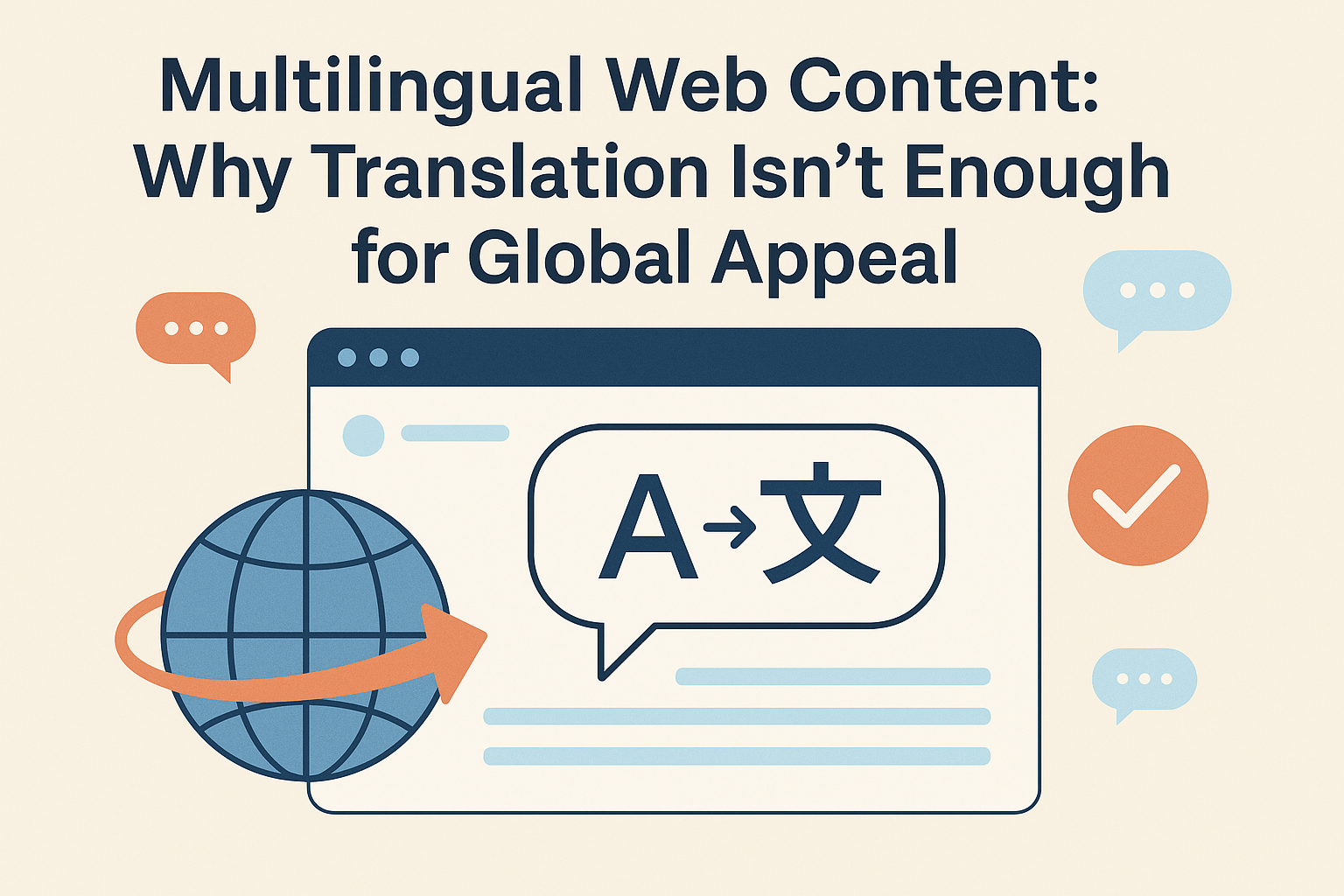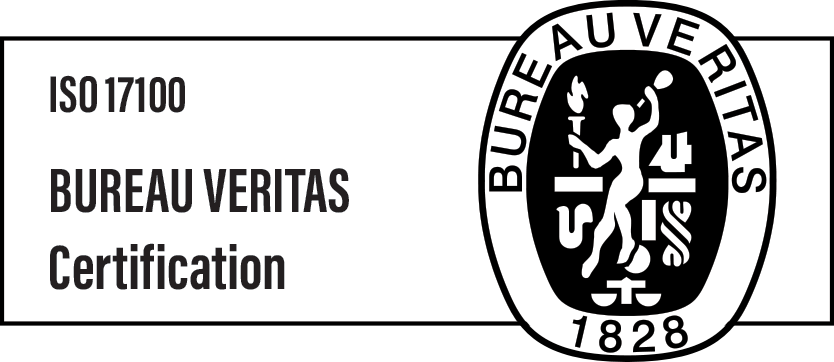Multilingual web content: why translation isn’t enough for global appeal

More than words—building global web experiences that resonate
Translating a website into multiple languages is often seen as the final step toward going global. Many businesses believe that once their content is translated, they’re ready to engage international users. But while translation is essential, it’s rarely enough. True multilingual web content localization goes beyond swapping words from one language to another. It’s about shaping your content so that it feels natural, relevant, and intuitive for each target audience.
Web users expect content that speaks their language—not just linguistically, but culturally and contextually. A website that looks and sounds local builds trust, improves usability, and supports conversion goals. Literal translation, on the other hand, can create confusion, lead to clumsy phrasing, and make users feel like they’re reading something foreign or out of place.
This article explores the difference between simple translation and a full localization strategy for multilingual websites. We’ll break down the limitations of direct translation, highlight the value of cultural adaptation, and explain how language service providers (LSPs) can help businesses connect more deeply with global audiences. For anyone managing international content, this is a practical look at why successful localization starts with more than just language accuracy.

Why direct translation falls short
Why direct translation falls short
Literal translation might get the message across, but it often misses the mark in terms of engagement and user experience. One of the main problems with direct translation is that it treats language as a mechanical substitution. Words and sentences may be technically correct, but they often sound awkward, flat, or out of place when read by a native speaker.
This is especially true on the web, where tone, microcopy, and user intent are essential. A call-to-action that works perfectly in English may come across as too pushy, too vague, or simply odd in another language if it’s translated word for word. Dropdown menus, error messages, or instructional content can lose clarity or meaning when literal translation is applied without considering context.
Even well-constructed translations can fail to connect if they ignore cultural preferences. Colors, humor, idioms, and formality levels all vary by market. Without adapting for these nuances, brands risk sounding robotic—or worse, alienating users.
Multilingual web content localization addresses these gaps. It ensures that translated content aligns with the expectations of local audiences while staying true to the brand. It’s not just about translating words correctly; it’s about presenting them in a way that feels familiar and persuasive. This level of refinement is essential for digital content that needs to drive action, not just convey information.

Localization as a strategic asset
Localization as a strategic asset
Good localization turns a website into a custom experience, not just a translation. Multilingual web content localization means changing layouts, images, cultural details, and even how users move through the site. This is key for businesses growing in places where people browse and behave differently online.
Localizing content goes far beyond words. It includes changing visuals to reflect local culture, adjusting date and time formats, and rewriting parts of the text to match how people speak in each region. It also means thinking about how users search online in different languages. That’s important for SEO and visibility.
Companies that localize their web content don’t just sound more natural—they perform better. Localized websites often keep visitors longer, convert more users, and lead to fewer support questions. That’s because people understand the content more clearly.
For LSPs, localization services are more than just translation work. They offer a chance to guide clients in creating better user experiences. With the right approach, content becomes a powerful growth tool, not just a way to communicate.

Adaptation and transcreation for intent and tone
Adaptation and transcreation for intent and tone
While localization focuses on adjusting structure and cultural elements, some content needs an even deeper transformation. This is where adaptation and transcreation come into play. These approaches are especially useful for marketing materials, landing pages, or any high-impact copy where tone, emotion, and storytelling matter as much as accuracy.
Transcreation involves rewriting content from the ground up in the target language, preserving the original intent, voice, and purpose—but not necessarily the exact wording. It’s a creative process, led by native-language experts who understand both the source material and local audience expectations. For example, a catchy English slogan may need a completely different phrase in another language to evoke the same emotional response. Literal translation won’t cut it here.
Adaptation, often used in parallel with multilingual web content localization, addresses tone of voice, cultural taboos, humor, and user expectations. In some markets, a direct, energetic style works well. In others, a more formal or indirect tone builds trust. These nuances are critical to brand perception and conversion performance.
Businesses that invest in adaptation and transcreation see stronger engagement. Their messages feel personal, not foreign. For LSPs, offering these services means stepping beyond linguistic accuracy and becoming a creative partner. The result is content that feels like it was made locally, not translated globally.

Multilingual UX: designing with the user in mind
Multilingual UX: designing with the user in mind
Multilingual web content localization doesn’t stop with words. The structure and experience of a website also need to reflect local norms and preferences. User experience (UX) varies widely by region, and failing to adapt for that can lead to friction, confusion, or abandonment.
Consider navigation menus, for example. Some languages require more space due to longer words or characters. Text expansion can affect button sizes, menu layouts, and mobile responsiveness. A layout that works in English might break when translated into German or Polish. Multilingual UX planning ensures that the design supports all language versions without sacrificing usability.
Forms and microcopy also matter. Small phrases like “Sign up” or “Forgot your password?” need to be localized not just in language, but in intent and clarity. Payment options, address formats, and input validation rules differ across markets. Without localized UX, even well-translated content can fall short during critical interactions.
Cultural context plays a role too. The way people read, scroll, or expect content to be organized varies. A homepage design that appeals to American users may feel cluttered or aggressive to users in Japan. Localization specialists working with UX designers can ensure that multilingual web content feels intuitive for every audience.
The more a site adapts to local expectations—visually and functionally—the more it earns user trust. And trust is what leads to engagement, loyalty, and long-term success in global markets.

Quality, consistency, and global governance
Quality, consistency, and global governance
Creating multilingual web content isn’t just about correct words or a polished layout. It’s also about keeping your message consistent and high-quality over time. Without a clear plan for how content is adapted, things can quickly become messy or confusing across languages.
This is where content governance matters. It means having glossaries, style guides, and voice guidelines that are used across all markets. A central system helps make sure product names, key phrases, and brand messaging stay consistent everywhere. It also helps avoid problems like “translation drift,” where meaning changes slowly over time.
Language service providers do more than just translate. They set up systems that keep content quality high across all languages. Tools like translation memory software, review workflows, and local language experts help manage this process. They make it easier to update content, keep the tone consistent, and ensure every version matches the original’s intent.
With strong governance in place, localization becomes a repeatable and reliable process. That’s key for any business growing into new markets without losing its voice or brand identity.

Translation gets you there—localization keeps you connected
Translation gets you there—localization keeps you connected
Translation is just the start of reaching a global audience. But to truly connect with users in different countries, businesses need to go further. That’s where multilingual web content localization plays a key role. It brings language, culture, and design together to create a full local experience.
Localization turns a standard website into one that feels natural to each user. It adjusts not just the words, but also the tone, layout, and message. This helps people trust the brand, enjoy the experience, and feel that the content was made for them.
Language service providers are in a great position to lead this process. They guide companies away from the risks of literal translation. They also support the tools and systems needed to deliver high-quality content across many markets.
In today’s global world, successful brands are the ones that pay attention and adapt. So don’t stop at translation. Localize your content. Make it work for each audience. And build real connections that go beyond language.

